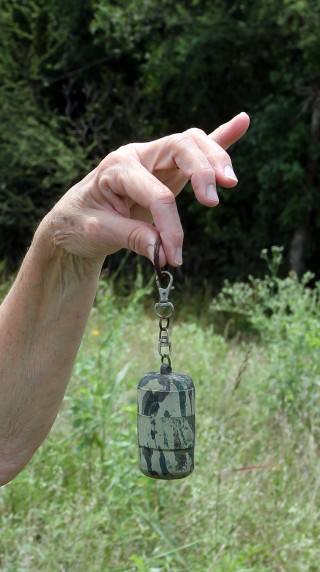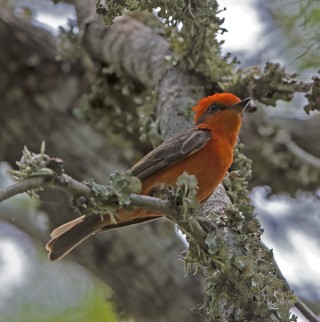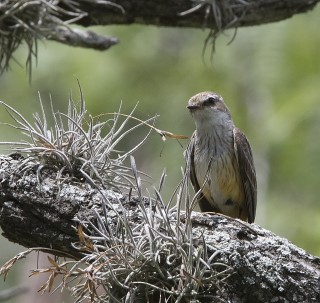
Although geocaches come in various sizes and shapes, many caches are similar to this small container we found hanging in a tree near the Medio Creek Bridge west of Normanna. Beneath the tightly sealed lid was a rolled up strip of paper on which to note the date we found this cache. Robert Benson photo.
27 May 2016 – Where Will the Big Red Arrow Take You?
It was HOT. A mosquito bit me. My eyes filled with sweat and I could barely see. Still, I followed the Big Red Arrow to the hackberry tree and began looking around the tree and its lower branches. Where was the thing?
What was I doing? It was crazy hot and I felt a grass bur in my sandal. However, I remembered that I am a naturalist and should be used to such things. I continued my search. Ah, there it was, in a hollow at the base of the tree: A small plastic container covered with camouflage tape.
I popped the lid on the little box and inside was a rolled up “logbook,” a gift card for auto service, and a trinket. I had found the geocache!
You probably have heard of geocaching. It is a kind of “treasure hunt” for hidden objects. It is a modern version of Hide-and-Seek that uses the Internet, a GPS receiver, or an “app” on an iPhone.
We started the adventure by tapping a map symbol on the screen of our smartphone. A compass popped up. A red arrow showed us which direction to head. The app told us how far away we were from the cache, first in miles then, as we got closer, in feet. It pinged when we were within 30 feet of the cache.

The spectacular male Vermilion Flycatcher is one of my favorite south Texas birds. To catch a glimpse of the “Brasita de fuego,” as they call it south of the border, is an experience you will not forget. This rather friendly male was guarding his nesting territory in Veteran’s Memorial Park near the location of a hidden geocache that we tracked down with our smart phone app. Robert Benson photo.
After finding the cache, we were supposed to sign and date its logbook. Okay, but darn it all, we had no pencil. We had to go back to the car. I carried the container to the car, but I was beginning to feel woozy from the heat and humidity. We noted our find on the logbook and prepared to return the geocache container back to its coordinates. Uh-oh, no lid!
We could not put it back without the lid! The log would get wet with dew and decompose. So began our secondary search…for the lid. Back through the grass and sticker burs, searching, searching. Frustrated, and about to drive to Wal-Mart for a replacement container, we looked down. There it was on the floorboards of the car. Exhausted and hot, we put the geocache back.
How did we get involved in this “treasure hunt?” Well, at the time, it seemed like a good idea to combine the popular sport of geocaching with birdwatching. We would find the cache and then note what birds were in the vicinity. It was a naturalist’s dream: get people outdoors and excited about finding treasure…but also notice Mother Nature while they are out there.
Our first geocache find was an olive green Army-surplus container about the size of a Bandaid box. The container had the words “Poisonous Contents” in raised letters on the lid. I was ready to put it back! Robert assured me it must be a recycled container and opened it. Inside we found a folded-up logbook and a couple of trinkets. We signed and dated the log. About a dozen other people had previously found this geocache. This was kinda cool!

The female Vermilion Flycatcher, still elegant to my eye, wears more subdued colors to help protect her from predators that might see her on her nest. She sat quietly watching from a tree limb as Robert and I searched for our geocache. Robert Benson photo.
We sealed it up and put it back in the exact same location. Then we noted the birds in that area: Painted Bunting, Bronzed Cowbirds, a Mockingbird. We would enter this information in the geocaching website later. The birdlist was our idea of an “upgrade” to geocaching.
As it turns out, birdwatching and geocaching naturally complement each other. Some cache-hunters also note the tree species in the area, or geological features. Geocaching is great outdoor recreation for naturalists, kids, and the whole family!
Along with the caches we also found lots of birds including a Bewick’s Wren, a melanistic Red-tailed Hawk, a beautiful male Lesser Goldfinch, and at Veteran’s Memorial Park, a strikingly colored Vermilion Flycatcher. He even had a mate. The Vermilion Flycatchers were breeding right there next to the cache! It was quite a nice find for us birdwatchers/geocache-ers.
The Vermilion Flycatcher cache had a faux diamond in it. I was tempted to take it as a souvenir but geocaching ethics say not to take anything from a cache unless you replace it with something of equal or greater value. I had nothing to trade right then. Maybe I will start carrying around some little bird figurines to trade.
When I researched the rules of geocaching on the Internet, I found out it is a pretty big deal. It has gone global. You can find geocaches almost everywhere. As of this writing, Geocaching.com shows 40 caches within a 10-mile radius of the Bee County Court House.
Children love geocaching, especially if they can take a trinket from the box. It gets kids and grown-ups outside where they can also enjoy nature, geology, even history.
Obviously, I am “sold” on geocaching. I am not the only one. Texas Parks and Wildlife (TPWD) is promoting geocaching in the state parks. Join the free Texas State Parks Geocache Challenge at TPWD and earn rewards such as keychains, discounts at the gift shops, even free admission and camping. It is a fun way to enjoy the great outdoors!
If you would like to offer comments, please click through to the discussion page
